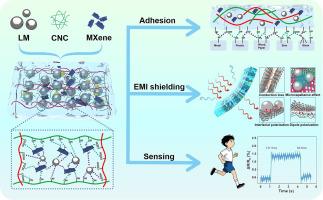Liquid metal integrated cellulose nanocrystal/polyacrylic acid dual-network hydrogel towards high-performance wearable sensing and electromagnetic interference shielding
IF 14.3
1区 材料科学
Q1 MATERIALS SCIENCE, MULTIDISCIPLINARY
引用次数: 0
Abstract
Simultaneously achieving high electrical conductivity, exceptional mechanical strength, and strong adhesion in hydrogel sensors remains a significant challenge. In this study, a dual-network cellulose nanocrystal/polyacrylic acid (CNC/PAA) conductive hydrogel integrated with liquid metal, Ti3C2Tx MXene, and lithium chloride (LiCl) as conductive fillers was developed. With superior electrical conductivity (3.17 S/m), remarkable strain tolerance (1381% strain, strength of 142.8 kPa), and excellent adhesion (24.72 kPa), the conductive hydrogel sensor exhibits high sensitivity (gauge factor = 3.28 across a 1000% strain range) and outstanding response characteristics (response time of 131.5 ms and recovery time of 86.2 ms). Notably, the hydrogel sensor demonstrates impressive stability during 2000 s of cyclic loading at 100% strain and detects subtle strains as low as 1%, enabling accurate recognition of various human movements. The dual-network PAA/CNC structure, coupled with the synergistic conductivity from the multifunctional fillers, further confers excellent electromagnetic interference shielding performance (37.42 dB at 2 mm thickness). This cellulose-based platform integrates high conductivity, mechanical resilience, and multiscale sensing capabilities, offering a sustainable and scalable solution for next-generation wearable electronics and smart devices.

液态金属集成纤维素纳米晶/聚丙烯酸双网络水凝胶面向高性能可穿戴传感和电磁干扰屏蔽
同时在水凝胶传感器中实现高导电性、卓越的机械强度和强附着力仍然是一个重大挑战。本研究以液态金属、Ti3C2Tx MXene、氯化锂(LiCl)为导电填料,制备了一种双网状纤维素纳米晶/聚丙烯酸(CNC/PAA)导电水凝胶。该导电水凝胶传感器具有优异的电导率(3.17 S/m)、应变容限(应变为1381%,强度为142.8 kPa)和粘附性能(24.72 kPa),具有高灵敏度(在1000%应变范围内的测量因子 = 3.28)和优异的响应特性(响应时间为131.5 ms,恢复时间为86.2 ms)。值得注意的是,水凝胶传感器在2000秒的100%应变循环加载期间表现出令人印象深刻的稳定性,并检测到低至1%的细微应变,从而能够准确识别各种人体运动。双网络PAA/CNC结构,再加上多功能填料的协同导电性,进一步赋予了优异的电磁干扰屏蔽性能(在2mm厚度下为37.42 dB)。这种基于纤维素的平台集成了高导电性、机械弹性和多尺度传感能力,为下一代可穿戴电子产品和智能设备提供了可持续和可扩展的解决方案。
本文章由计算机程序翻译,如有差异,请以英文原文为准。
求助全文
约1分钟内获得全文
求助全文
来源期刊

Journal of Materials Science & Technology
工程技术-材料科学:综合
CiteScore
20.00
自引率
11.00%
发文量
995
审稿时长
13 days
期刊介绍:
Journal of Materials Science & Technology strives to promote global collaboration in the field of materials science and technology. It primarily publishes original research papers, invited review articles, letters, research notes, and summaries of scientific achievements. The journal covers a wide range of materials science and technology topics, including metallic materials, inorganic nonmetallic materials, and composite materials.
 求助内容:
求助内容: 应助结果提醒方式:
应助结果提醒方式:


